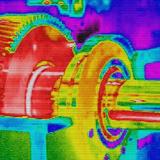Infrared Technology
Emissivity is the measure of an object's ability to emit infrared energy. Emitted energy indicates the temperature of the object. Emissivity can have a value from 0 (shiny mirror) to 1.0 (blackbody). Most organic, painted, or oxidized surfaces have emissivity values close to 0.95. Majority of Fluke Process Instruments sensors have adjustable emissivity feature to ensure accuracy when measuring other materials such as shiny metals.



